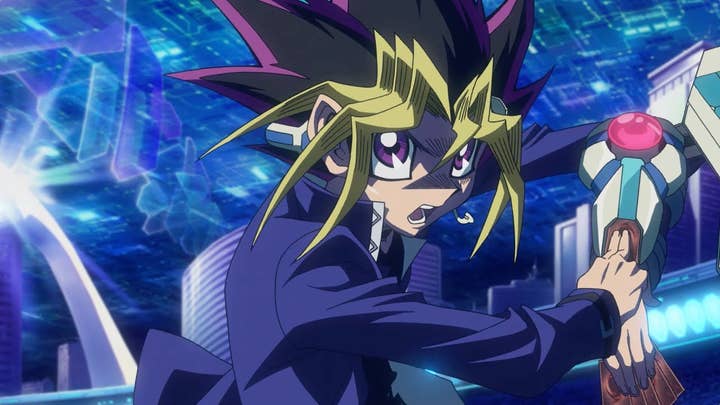How 25 years of Yu-Gi-Oh prepared Konami for live service games
Konami developers discuss how games make the media franchise one of its most popular series
Sign up for the GI Daily here to get the biggest news straight to your inbox
Shortly after Yu-Gi-Oh became a serial anime inspired by the late Kazuki Takahashi's manga, it spurred on an official card game and video game franchise. With each iteration of the animated series, the card game has seen new cards, and the video games have continued in their own way.
Now 25 years later, Konami's digital card game is one of its most popular series. GamesIndustry.biz sat down with senior Konami developers behind the Yu-Gi-Oh games to discuss their commercial success over the years.
During the early 2000s (2000-2005), when the anime was rising in popularity, Konami had a spike of Yu-Gi-Oh title launches across multiple platforms. In just five years, the publisher released over 20 titles globally, games such as Yu-Gi-Oh! The Duelists of the Roses, Yu-Gi-Oh! The Falsebound Kingdom and Yu-Gi-Oh! Worldwide Edition: Stairway to the Destined Duel.

Konami Digital Entertainment US senior producer Charles Murakami explains that the release schedule back then was not just a business one. It was to provide fans of the series an option to play the games on their console of choice.
"Usually, the push for more titles came from the fans, especially from those that wanted to try out the latest cards. To have an authentic card game experience, each player needs their own screen for competitive play. Online console multiplayer was still in its infancy in the early 2000s.
"So handheld devices were a natural fit to simulate the physical card game. Home console titles had unique Yu-Gi-Oh games based around the monsters, characters, and themes from the anime instead."
New game releases were also a means to keep up the growing content from both the TV program and print card game. Attempting to match this required a lot of work from Konami's Digital Entertainment division. Murakami reminds GamesIndustry.biz that the media franchise's audience has different fan sub-groups, and the digital games have tried to cater to them.
"Some [people] love the anime. Some are [more] focused on the card game. We try to have something for everyone"Charles Murakami, Konami
The senior producer says, "Some [people] love the anime and the characters. Some are [more] focused on the card game — some like the designs of iconic monster cards, etc. Most Yu-Gi-Oh players fit into one or even all of these [categories]. So, we try to have something for everyone.
"This also allowed for a variety of games to service different audiences. Yu-Gi-Oh! Worldwide Edition: Stairway to the Destined Duel was authentic to the card game. While Yu-Gi-Oh! 5D's: Wheelie Breakers put the player in a d-wheel [from the 2008 series] to mimic the TV show. By 2015, we created Yu-Gi-Oh Legacy of the Duelist for not just the current anime audience but for players that have enjoyed the game throughout its long history."
Murakami explains that the Yu-Gi-Oh game brand established itself after the sales of the first Game Boy title, Yu-Gi-Oh! Duel Monsters for Japan back in 1998. After the original Duel Monsters show starring Yugi Muto (known simply as Yu-Gi-Oh in the West) began airing in 2001 and became an international hit, 2002 was a good time for Konami to release more titles globally. Also, before online gaming became commonplace, the series sold the most on handheld game devices.
In 2005, Konami launched Yu-Gi-Oh Online on PC. The title was one of the company's early free-to-play title forays for the franchise. It would then receive updated versions and was eventually taken offline in 2012.
"The success of our live updating titles since Duel Links has resulted from using technology...not only from past Yu-Gi-Oh: Online titles but also from other Konami titles"Charles Murakami, Konami
Murakami explains that the title helped pave the way for the success of future live service games.
He says, "We believe that the success of our live updating titles since Yu-Gi-Oh: Duel Links has resulted from using technology and operational knowledge not only from past Yu-Gi-Oh: Online titles but also from other Konami titles. Each one gave insight on what did or didn't work, and they helped mold the next title."
By 2010, as the third anime series was airing, Murakami says that games were still developed for show fans. "In [the] anime series, characters play the latest and often future cards in the card game. Since fans want to play with new cards, focusing the game around the latest animated show was natural," he explains.
The official trading card has a catalog of over 10,000 cards in print. Rules are consistently updated to keep the game balanced; one of those efforts is updating what cards are limited or forbidden for official play. Konami also took those rule updates and tried implementing them as it saw fit.
"We take various aspects into consideration," Murakami explains. "For live updating games, we regularly analyze how the game is played on the server and make changes to the regulations to ensure that as many users as possible can enjoy the game."
Konami would then pivot more to live service games with the launch of Yu-Gi-Oh Duel Links in December 2016 in Japan and internationally in January 2017. The title would prove to be commercially viable for the publisher. In the first six months of 2021, it was reported to have earned $110 million in global player earnings.
However, the shift to free-to-play was not easy from an operations standpoint, according to Kenichi Kataoka, senior producer of Konami Digital Entertainment Japan.
"We thought it was almost impossible. You can imagine how many servers would be needed..."Kenichi Kataoka, Konami
"At the time, we thought it was almost impossible. You can imagine how many servers would be needed for the huge number of [users] to play duels on a daily basis. The operating costs would also be considerable," he says.
"[Duel Links] has been downloaded more than 150 million times, and many users are enjoying the game. We can consider various possibilities for the project but only choose to allow fans to purely enjoy the world of Yu-Gi-Oh."
Six years later, the most challenging part for the development team maintaining the game has been keeping players returning for more.
Kataoka explains, "I think all mobile game developers know this problem. It is necessary to accurately analyze the situation at any given time, adjust and keep users engaged in the game. [As well as] implement measures that appeal to both new users and fans of Yu-Gi-Oh. It takes a lot of energy and passion to keep this up over the years. The production staff's love for Yu-Gi-Oh is why we can make it feasible."
To that point, Duel Links features content and cards that span nearly the entire Yu-Gi-Oh franchise. Players can engage in the narratives of Yugi Mutou vs rival Seto Kaiba, the Battle City arc, and Yu-Gi-Oh Vrains, the 2017 TV series that introduced link summoning. The senior producer adds that big content updates are planned out more than a year in advance.

Taking those lessons and ongoing success, Konami released the multiplatform free-to-play game Yu-Gi-Oh Master Duel in January of last year. The game's mobile version alone hit $130 million throughout 2022 and reached 50 million downloads by November.
Yumi Hoashi, US senior vice president of Konami Digital Entertainment, says that when compared to Duel Links, Master Duel is a live service game that appeals to a different demographic. The game is a digital version of the official trading game and is not heavily inspired by the TV franchise.
Hosahi says, "Duel Links caters more to fans of the Yu-Gi-Oh IP, so this game is robust as it pertains to fans of the various animated series, with rich character development of the characters from the anime. Meanwhile, [Master Duel] provides a definitive digital experience of the card game and is robust with other elements, such as the single-player content that follows the lore of the deck themes."
Kataoka explains that Master Duel being a simultaneous release, was perhaps the most challenging part for the development team.
"It would have been a little easier if we could have staggered the distribution timing for each platform..."Yumi Hoashi, Konami
He says, "To deliver [the title] to a large number of users, we planned to offer the game on multiple platforms. However, it was more difficult than we imagined to develop the game simultaneously according to the rules of each platform. It would have been a little easier if we could have staggered the distribution timing for each platform, but that would have been unfair to the users of the platforms that would join later."
When asked what has kept Yu-Gi-Oh commercially viable as a video game for 25 years, Murakami summarizes.
"Yu-Gi-Oh is already a fun card game, and it also has an anime with fun, recognizable characters with a compelling story and memorable villains. Some of these characters also play the card game in the program. The gameplay, story, and characters are pre-established, and many fans are familiar with the various elements, so we believe it has been a relatable title for a long time."
Sign up for the GI Daily here to get the biggest news straight to your inbox

